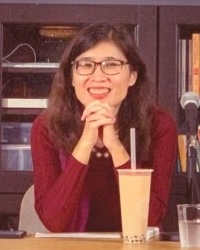
The True Face of Fang Lizhi
The True Face of Fang Lizhi was edited by the General Office of the Central Commission for Discipline Inspection of the Communist Party of China and published by Law Press in July 1989.
Fang Lizhi was one of Beijing's most prominent intellectuals during the 1989 Tiananmen Square Democracy Movement. An astrophysicist, he was labeled a "rightist" in his earlier years. Starting in the autumn of 1988, he actively participated in political study groups at Beijing's universities and gave interviews to foreign media, openly criticizing the Chinese Communist Party's Four Cardinal Principles, which called for upholding socialism and the Communist Party rule. His views resonated with students in Beijing at the time.
On January 6, 1989, he penned an open letter to then-Central Military Commission Chairman Deng Xiaoping, suggesting that democracy activists like Wei Jingsheng be released that year for the National Day celebrations. In February 1989, Fang Lizhi wrote "China's Hope and Disappointment," which Wang Dan and others posted as a big-character poster at Peking University. In June 1989, the CCP authorities issued an arrest warrant for Fang Lizhi on charges of "counter-revolutionary propaganda and incitement." Fang subsequently sought refuge in the U.S. Embassy and later sought exile in the United States.
This book serves as a propaganda tool for the Chinese Communist Party, compiling Fang Lizhi's what the book called "reactionary statements" where he "opposed the Four Cardinal Principles and advocated bourgeois liberalization." It also gathers articles from Chinese Communist Party newspapers that criticize Fang Lizhi for "inciting and organizing the June Fourth riots." From an official government perspective, the book offers insights into Fang Lizhi's ideas and sheds light on China's social and political thought environment before and after June Fourth.

Cai Zheng
Cai Zheng was born in Hong'an, Hubei Province, in 1965. He pursued his education at Huanggang Teachers College, specializing in English from 1981 to 1984. After graduating, he returned to his hometown to work in agriculture. In October 1985, he enlisted in the military, serving in a unit of the Beijing Air Force.
Following his demobilization in 1990, he became a teacher at a middle school in his hometown. From 1991 to 1994, he studied in the History Department at Central China Normal University. After graduating, he worked at a library in Beijing. From 1996 to 2000, he pursued his Ph.D. in Sociology at the University of Illinois Chicago.
Cai Zheng is the author of several works, including the memoir, <i>An Eyewitness Account of 1989: A PLA Soldier's Memoir</i> (Mirror Books, 2009); the short story collection, <i>Seeds</i> (Changjiang Literature and Art Publishing House, 2013); the essay collection, <i>The Direction of Life</i>; and the short story collection, <i>Huang'an Stories</i>.

An Eyewitness Account of 1989 by a PLA Soldier
An Eyewitness Account of 1989 by a PLA Soldier is written by Cai Zheng. In 1989, Cai Zheng was serving in the People's Liberation Army Air Force in Beijing. On June 5th, near Tiananmen Square, he was arrested and severely beaten by martial law troops after he protested against the massacre. He was then detained for over eight months at the Beijing Xicheng Public Security Bureau and by his own military unit, enduring torture. Afterward, he was sent back to his hometown of Hong'an in Hubei province.
The book offers a detailed account of Cai Zheng's experiences as a soldier during the June Fourth crackdown and his subsequent struggles for survival in his hometown. It provides valuable insights for researchers seeking to understand China's social and historical environment before and after the events in 1989.
Published in 2009 by Mirror Books, this memoir is held in various public libraries in Hong Kong and by many university libraries worldwide. The book has also been subject to pirated editions within China.
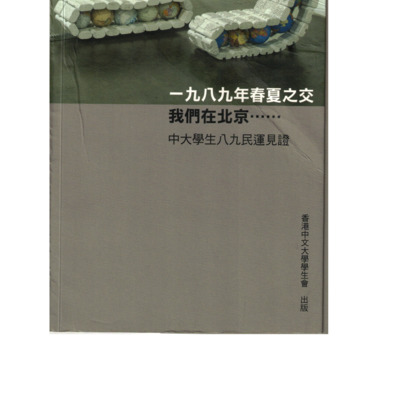
Summer of 1989: We Were in Beijing
<i>Summer of 1989: We Were in Beijing...</i> compiles numerous firsthand accounts detailing the experiences of students from The Chinese University of Hong Kong (CUHK) who were in Beijing and Shanghai during the 1989 democracy movement. A total of thirty CUHK students traveled from Hong Kong to Beijing to show their support.
The Hong Kong students interacted with student movement leaders at the time, attended meetings of the Beijing Students Autonomous Federation, participated in organizing efforts, and even edited a publication called <i>News Express</i>. They also set up a supply station of provisions in Tiananmen Square and supported the establishment of "Tiananmen Democracy University." A number of these students personally witnessed the June Fourth crackdown.
On the eve of the crackdown, official broadcasts in the square sternly criticized students from “a certain Hong Kong university” for forming illegal organizations. <i>People's Daily</i> directly named and criticized the Chinese University of Hong Kong Student Union on June 15th, after the crackdown occurred.
The Chinese University of Hong Kong Student Union published this book in 2014, stating its purpose as safeguarding history and combating official brainwashing. It also hopes that readers will understand the Tiananmen democracy movement from the perspective of Hong Kong students and to explore the role of CUHK and Hong Kong academia in this movement.

A Chronicle of Heroes in Quelling the Turmoil
<i>A Chronicle of Heroes in Quelling the Turmoil—A Collection of Reports on the Deeds of Heroes and Models in Suppressing the Counter-Revolutionary Rebellion in Beijing</i> was published by Guangming Daily Publishing House in September 1989. As one of the Chinese Communist Party's official propaganda projects after the suppression of June Fourth, this book collected speeches from a nationwide speaking tour organized by the authorities after the suppression to publicize the "great achievements in quelling the counter-revolutionary rebellion." It is one of the texts for studying June Fourth from the official perspective.

One Day Under Martial Law
<i>One Day Under Martial Law</i> was edited by the Cultural Department of the General Political Department of the Chinese People's Liberation Army (PLA), and published and distributed by the PLA Literature and Art Publishing House in October 1989.
The book is divided into two volumes and collects a total of 190 signed articles. Apart from a few police officers from the Beijing Municipal Public Security Bureau at the time, almost all the authors were soldiers from the PLA martial law troops.
This book is a valuable resource provided by the martial law troops, a special group of witnesses to the June Fourth Tiananmen Incident. The book is a valuable source of information for researchers seeking information on the troops that participated in the June 4th massacre.
This book was also a primary reference for scholar Wu Renhua when he wrote the book <i>The Martial Law Troops in the June Fourth Incident</i>. As an officially organized piece of propaganda material, the book's original intent was to applaud the troops and individual officers and soldiers for what the government described as "quelling the counter-revolutionary rebellion." However, because it revealed too much true information, the book was banned shortly after publication. In 1990, the publisher reissued what it called a "selected edition" of the book, which removed over a hundred articles, retaining only 80 signed articles, and the total word count of the book was reduced by more than half. The Archives has collected the original two volumes of <i>One Day Under Martial Law</i>, as well as the “selected edition" that was published after being censored.

Modern Women Journals Database
This database is part of the “Modern History Databases,” operated by the Institute of Modern History of Academia Sinica in Taiwan. The "Women and Gender History Research Group" of the Institute endeavors to collect, digitize and categorize related books and journals from libraries worldwide, and established the Modern Women Journals Database, which consists of 214 journals and 110,000 individual items. The database has been made available for public use since 2015.
In 1919 and the years that followed, women’s movement in China was on the rise, and as a result, many women's magazines appeared, a lot of which were run by women. Most of the journals collected in this repository were published between 1907-1949, with some published after 1949; there are comprehensive publications, as well as those focusing particularly on women's movements, family, health, employment, etc.; nearly a quarter of the publications were published in Shanghai, followed by Beijing, Guangzhou, and Nanjing. As can be seen from the Database, most of these journals have a relatively short duration, ranging from one to five years. Through this database, readers can gain a more comprehensive understanding of the history of women and women’s movements in modern China.
In addition to browsing journals and searching the database, users can also conduct author research and journal analysis. Under the author research section, users can read author biographies, as well as see the number of articles written by a particular author, and a map displaying their family and social relations. Under the journal research section, users can generate maps by keywords, eras, and article categories, which can provide more multi-dimensional information about a specific era or topic.
Link to the database:https://mhdb.mh.sinica.edu.tw/magazine/web/acwp_index.php. Thanks to the Institute of Modern History, Academia Sinica, for authorizing the CUA to repost.

Modern Women’s Biographies Database
The Modern Women’s Biographies Database is part of the Modern History Digital Database of the Institute of Modern History, Academia Sinica, Taiwan. The goal of the database is to create biographical information on women in modern China, in order to counter the dominance of biographies of male figures in modern China history. The database includes biographies of 1,848 women in modern China, a few of whom were not Chinese but were included because they taught at universities in China or Taiwan.
In addition to browsing and searching for biographies, the database provides two additional functions: 1. “Biography Connections”: users can select multiple biographies to generate a map displaying social connections among selected figures; 2. “Place of Origin Map”: a map presenting the places of origin and eras of the figures, and users can click the markers on the map to read the biographies of the figures. By visualizing the biographical information, users can have an overview of the organizational networks of modern women's groups, as well as the development of women's discourse.
Link to the database: https://mhdb.mh.sinica.edu.tw/women_bio/index.php. Thanks to the Institute of Modern History, Academia Sinica, for authorizing the CUA to repost.

The Ladies Journal
The Ladies Journal was founded in January 1915 by the Commercial Press Shanghai. It was a monthly magazine primarily targeting upper-class women. It ceased publication in 1932 when the Commercial Press was destroyed by Japanese bombing. The magazine was distributed in major cities in China and overseas, such as Singapore. The magazine was considered an influential forum for the dissemination of feminist discourse in modern China, given its long operation and large readership.
The magazine spanned important historical periods such as the May Fourth Movement and the National Revolutionary period, and readers can see how the political environment and social trends influenced the political stance and style of the publication.
Although it was a women's magazine, the chief editors and the authors of most of the articles were men. According to Wang Zheng, Professor Emeritus of Women's and Gender Studies and History at the University of Michigan, the early articles of The Ladies Journal were more conservative. Although it advocated for women’s education, the goal was to train women to be good wives and mothers. Later, under the influence of New Culture Movement and the May Fourth Student Movement, the magazine was forced to reform itself and began to publish debates on women's emancipation as well as to call for more women's contributions, spread liberal feminist ideas, and support women's movements across the country.
1923 saw the beginning of the National Revolutionary period, and the Chinese Communist Party’s nationalist-Marxist discourse on women’s emancipation started to challenge liberal feminism, and the magazine's influence waned. In September 1925, the magazine ceased to be a cutting edge feminist publication after it changed its chief editor again and shifted its focus to ideas more easily accepted by conservative-minded readers,such as women's artistic tastes.
Although the <i>The Ladies Journal</i> was run by men, and some articles displayed contempt for and discrimination against women, it pointed out and discussed many issues that hindered women's social progress, such as lack of education, employment, economic independence, marriage freedom, sexual freedom, family reform, emancipation of slave girls, abolition of the child bride system, abolition of prostitution, and contraceptive birth control. It was also open to many different ideas and views, all of which were published. It is a valuable historical source for the study of women's studies and modern Chinese history.
Yujiro Murata, a professor at the University of Tokyo, founded the The Ladies Journal Research Society in 2000, along with a number of other colleagues interested in women's history from Japan, Taiwan, China, and Korea. The two main goals of the Society are to produce a general catalog of all seventeen volumes of the Magazine and to bring together scholars from all over the world to conduct studies based on the magazine. With the assistance of the Institute of Modern History of Academia Sinica in Taiwan, the magazine was made into an online repository, which is stored on the Institute’s “Modern History Databases” website, and can be accessed by the public.
Link to the database: https://mhdb.mh.sinica.edu.tw/fnzz/index.php. Thanks to the Institute of Modern History, Academia Sinica, for authorizing the CUA to repost.

Wang Yiwei
Wang Yiwei (1905-1993), also known as Wang Naiyi, a native of Minhou, Fujian Province, was a leading Chinese journalist and publisher of women’s publications during the Republican era and early years of the People’s Republic.
Wang attended the Shanghai Girls' Middle School (now Shanghai No. 3 Girls' Middle School), which was run by an American church with the aim of spreading Christianity to Chinese women. However, because she did not accept the teaching style and the fact that most of the students at the school came from rich families, Wang dropped out and completed her studies through self-learning. She then enrolled in China's first co-educational school founded by Feng Yuxiang, a general of the National Revolutionary Army.
After graduation, Wang was first admitted to the Department of History of Nanjing University, and soon transferred to the Department of Journalism at Fudan University, which had begun accepting female students, and she aspired to be the first generation of female journalists in China.
After graduation in 1932, at the invitation of one of her classmates at Fudan University, Wang Yiwei worked as a field reporter for the women's section of the Morning Post, specializing in interviews with prominent women, during which she came to know Liu-Wang Liming, then president of the China Woman’s Christian Temperance Union. They decided to co-found the independent women's publication <i>The Women's Voice</i>, aiming at encouraging women to seek their own liberation as well as the liberation of the nation.
Due to differences of opinion between the two, in 1934 the magazine declared its independence and stopped receiving funding from the China Woman’s Christian Temperance Union. In order to raise funds, Wang Yiwei held charity events and sales, and solicited individual donations through her personal connections and the magazine’s network of supporters.
Because of its left-leaning stance and its sharp criticism of KMT policies, the magazine was severely censored and suppressed by the KMT authorities. According to Wang Yiwei's own account, she heard from a friend that her name was on a government blacklist. In 1935, <i>The Women's Voice</i> had to cease publication.
After the war against Japan broke out, Wang initially worked at the post office, but in order to continue her involvement in the revolution, she resigned and moved to Guangdong, where she was invited by Lu Suying, the director of the Cultural Department of the Women's Association of the Guangdong Provincial Government, to become the editor-in-chief of <i>Guangdong Women</i>. Shortly afterward, the provincial government moved to Guangxi to escape the Japanese army, and Guangdong Women ceased publication. Wang returned to Shanghai and became the editor of the women's section of the <i>Damei Weekly</i>, writing her own articles to encourage women to join the resistance against Japan. Later, the editor-in-chief of the publisher was assassinated by the Japanese and the newspaper was closed down.
After the victory against Japan in 1945, <i>The Women's Voice</i> resumed publication and Wang Yiwei continued to serve as its editor-in-chief. Due to continued persecution by the KMT, the publication eventually ceased operation in 1947 under both political and economic pressure. Wang Yiwei worked as a family teacher for a while. In 1962, she became a member of the Shanghai Research Institute of Culture and History, an honorary research institution with united front purposes established by the CCP to house pre-1949 intellectuals.
In interview with Wang Zheng, Professor Emeritus of Women's and Gender Studies and History at the University of Michigan, in her later years, Wang Yiwei said she was a strong believer in the CCP's ideology, but after CCP took power in 1949, she saw the inconsistency between its words and deeds, and realized that CCP was merely taking advantage of the women's movement.
For more information about the magazine, please see: <a href="http://sites.lsa.umich.edu/wangzheng/wp-content/uploads/sites/948/2024/11/%E7%8E%8B%E4%BC%8A%E8%94%9A-%E6%88%91%E4%B8%8E%E3%80%8A%E5%A5%B3%E5%A3%B0%E3%80%8B-1987.pdf">Wang Yiwei, “Me and the ‘Women's Voice’: A Tribute to March 8 Women's Day”</a> on the website of Wang Zheng, Professor Emeritus of Women's and Gender Studies and History at the University of Michigan.

The Women's Voice
The Women's Voice (Nüsheng), first issued in Shanghai in October 1932, was a bimonthly magazine published by the Women's Voice Society. It was co-founded by then journalist Wang Yiwei and Liu-Wang Liming, then president of the China Woman’s Christian Temperance Union, with part of the funding coming from the Union, and part being raised by Wang through advertisements and sales.
In the first issue of the journal, the magazine’s mission was described as “to seek liberation for the nation and happiness for all women.” The publication included short commentaries on political affairs, essays, literary works, and readers’ letters. Its content was wide-ranging, including many theoretical articles on the women's movement, discussions on women's participation in politics, marriage freedom, and professional development, reports on the situation of female workers, as well as women's lives in other parts of the world. Although <i>The Women's Voice</i> did not have any political affiliations, it identified with socialism and supported the Chinese Communist Party, believing that national liberation was a prerequisite for women's liberation.
Due to differences of opinion between editor-in-chief Wang Yiwei and president Liu-Wang Liming, the magazine declared its independence and was no longer funded by the China Woman’s Christian Temperance Union in 1934. Due to its left-leaning stance and its sharp criticism of Kuomintang policies, the magazine was subjected to severe censorship and suppression by the KMT authorities and was forced to cease publication in 1935.
After the victory over Japan in August 1945, <i>The Women's Voice</i> resumed publication in November and turned into a monthly magazine. In addition to issuing magazines, the editorial board also held several symposiums, such as “Women's Participation in Politics”, “Women's Education”, and “The Way Forward for Female Intellectuals” The magazine started to collaborate with Liu-Wang Liming again and changed its editorial policy to publish only works by women authors. According to Wang Yiwei, in order to maintain the magazine’s independence, they did not receive any political funding, and that most of its funding came from fundraising events and charity sales. Due to continued harassment by the Kuomintang, Liu-Wang Liming was forced to flee to Hong Kong. Eventually, under both political and financial pressure, <i>The Women's Voice</i> ceased publication in 1947.
<i>The Women's Voice</i> magazine is hosted by the <b><a href="https://mhdb.mh.sinica.edu.tw/magazine/web/index.php"> Modern Women Journal Database</a></b>, operated by the Institute of Modern History of Academia Sinica in Taiwan, and is free for users to register and access. The site contains all of the 1932-1935 issues, but most issues after 1945 were lost, thus only three issues are included. Thanks to the Institute of Modern History, Academia Sinica, for authorizing the CUA to repost.
For more information about the magazine, please see: <a href="http://sites.lsa.umich.edu/wangzheng/wp-content/uploads/sites/948/2024/11/%E7%8E%8B%E4%BC%8A%E8%94%9A-%E6%88%91%E4%B8%8E%E3%80%8A%E5%A5%B3%E5%A3%B0%E3%80%8B-1987.pdf"> Wang Yiwei, “Me and the ‘Women's Voice’: A Tribute to March 8 Women's Day”</a> on the website of Wang Zheng, Professor Emeritus of Women's and Gender Studies and History at the University of Michigan.
Note: In 1942, during the war against Japan, with the financial support of the Japanese and the Wang Jingwei regime , another magazine with the name of <i>The Women's Voice</i> was published in Shanghai, imitating the style and design of the original magazine. The magazine, edited by Japanese left-wing writer and feminist Toshiko Sato (also known as Toshiko Tamura, or Zuo Junzhi in Chinese), was the only women's magazine published in the fallen area of Shanghai under Japanese control. The magazine ceased publication in 1948.
According to research by Tu Xiaohua, an associate professor at the School of Journalism at the Communication University of China, although the magazine had long been regarded as a “traitorous” magazine and a tool of Japanese political propaganda, it also served as a platform for the dissemination of left-wing ideology to a certain extent, due to Toshiko's internationalist stance and the involvement of members of underground CCP members. The magazine is also included in the Modern Women Journals Database.
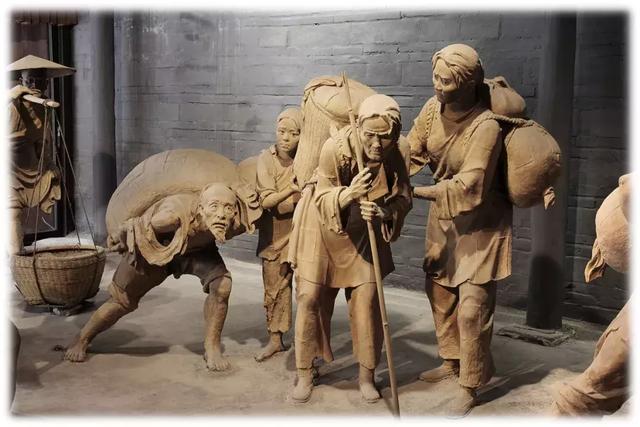
When Revolutionary Myths Collapse: Understanding Demonized Individuals--Reading Xiao Shu’s The Truth About Liu Wencai
The Truth About Liu Wencai restores the true identity of a person portrayed as a demon by the state, investigates the mechanisms by which truth is created, and explains why we so readily accept falsehoods.

Catastrophe and Rebirth: Songs from Maidichong
Amidst social transformation and political repression, what path will religion take in China?

The Truth about Liu Wencai
In the mid-20th century, Liu Wencai, a large landowner in Sichuan Province, spent almost all of his family's wealth in his later years on promoting education, bridge construction and road building, and was known as a great benefactor in the region. However, during the Great Leap Forward and the Cultural Revolution, he was portrayed as an archetype of evil landlords in the 3,000-year history of feudalism in China.
As the controller of great wealth in southern Sichuan during the Republic of China period, Liu Wencai did accumulate a huge fortune from plunder in his early years, but in his later years he invested most of it in public welfare. He financed and presided over the construction of a highway, as well as the Wanchengyan irrigation system, benefiting hundreds of thousands of farmers. He also spent almost all of his family's wealth to found the Wencai Middle School (today's Anren Middle School), which at the time was known as Sichuan's best privately-run school. In the memories of the local people, Liu Wencai collected less land rent than what was collected by the government after 1949. He was praised for providing financial assistance to poor families during special days and festivals, and for mediating civil disputes in a fair manner.
These facts were erased under the ultra-leftist propaganda. The authorities even fabricated the story of Liu Wencai keeping farmers in a dungeon filled with water, as well as making sculptures depicting how Liu Wencai was exploiting farmers, in order to incite hatred against him. This made Liu Wencai one of the most famous evil landlords in China.
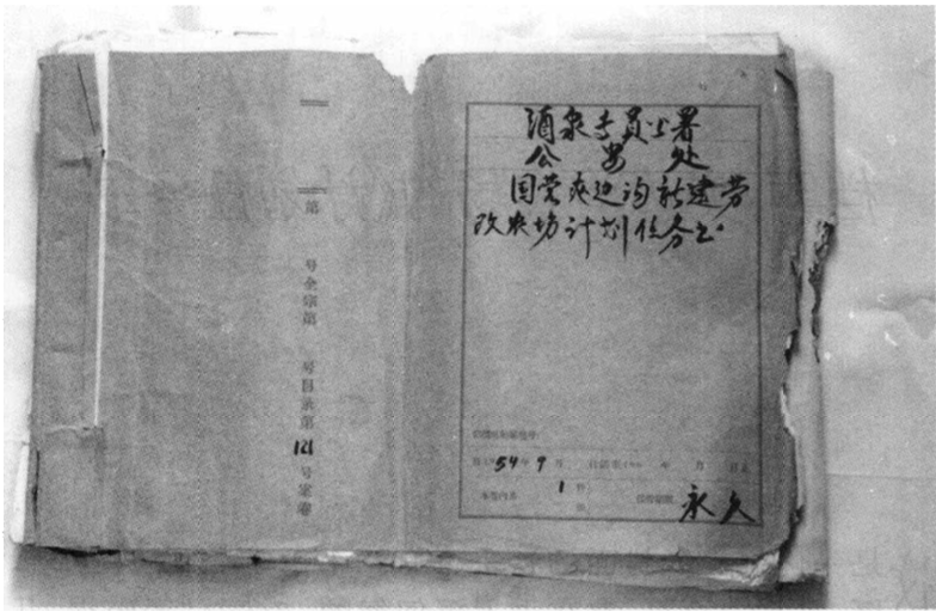
A Survivor Looks Back at China’s Most Notorious Labor Camp
Why the memories of Jiabiangou are worthy of our remembrance.

Major Feminist Events in China 2020-2023
This is a record and index of major feminist events in China between 2020 and 2023. The document consists of more than 2,000 pages, in which 122 topics/events related to feminism have been curated. The document is divided into five chapters: “Feminism in the Public Eye ”, “Feminism in Individual Cases”, “Feminism in the Law”, “Feminist Activism,” and “Three Special Years - Feminism amid COVID-19”.
Each event entry is divided into two parts: event summary and related articles The first part aims to provide a complete and objective overview of the event, using first-hand materials when possible; the second part collects media reports and commentaries on the event published through public media outlets and social media platforms.
This document covers a wide range of topics/events, including but not limited to commercial surrogacy, gender discrimination in higher education, China’s population policy and the reproductive rights of women, misogynistic culture in the media, the progress and challenges of the #Metoo movement, legal analysis of law and policies concerning feminist issues, and feminist activism.
The editorial group introduced their intention as follows in the document’s introduction:
“This document, though imperfect, is an attempt to contribute to the writing of the history of Chinese feminism - history is the road we are walking at the moment, and we've come a long way, still searching for answers hidden in the thick fog. ”
“We hope that this document will not only serve as a tool, but also provide the reader with wisdom and strength.”

Above Ground: China's Young Feminist Activists and Forty Moments of Transformation (English)
In March 2015, the arrest and detention of five activists in China brought international attention to the feminist movement in that country, which had already been battling gender discrimination, sexual harassment, violence against women, and homophobia for many years. While the West has only recently turned its attention to the “Feminist Five” and their fellow activists, China has a long and deep history of feminist thought and action. This exhibit seeks to make visible the work of recent feminist activists in China, to share their work with a broader audience, and to spark interest in the history and present of feminist activists, advocates, and scholars in China.
This digital exhibit is a faithful representation of a physical exhibit of the same name, which was hosted by the University of Michigan’s Institute for Research on Women and Gender from January through June 2016.
The exhibit (English) consists of 40 images depicting street actions and online campaigns initiated by young feminist activists, raising awareness and demanding government actions around issues of domestic violence, sexual harassment, education and employment equality, rights of sexual minorities and marginalized groups , and so on.
At the opening of the physical exhibit on January 26, 2016, Lü Pin, the curator of the exhibit and a long time feminist activist and researcher, remarked on the creative and subversive strategies of the young feminist activists:
“That’s why this was a story about visibility from the very beginning. First of all, they wanted people to have to notice this issue. Second, they wanted people to have to notice this group of people. ‘Noticing the issue’ was not just about making the issue of women’s rights become well-known, more importantly, it meant that the issue had to be accepted as a public issue that society would acknowledge as something that was very important. This was not something for women, or something private. Next, as we all considered this to be an important matter, the government had to respond. Thus, in this process, communication or media was very crucial, because it could amplify the power of the unknown.”
Using materials from the physical exhibit, this digital exhibit was created by librarians from University of Michigan Liangyu Fu (Chinese Studies) and Meredith Kahn (Women’s Studies), who created additional descriptive information for the images, as well as a bibliography of relevant sources.
Go to Exhibit: https://apps.lib.umich.edu/online-exhibits/exhibits/show/aboveground.
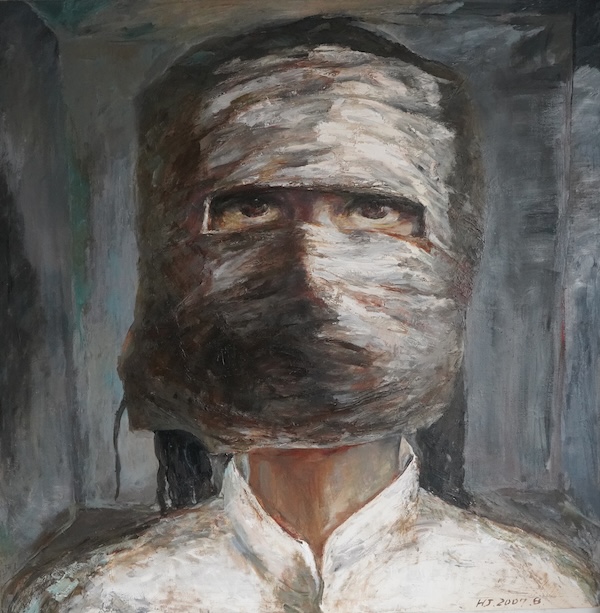
Remembering Lin Zhao
On the 57th anniversary of Lin Zhao's death, we at the China Unofficial Archives hope to highlight several key additions to our collection of works about Lin Zhao, in memory of one of the most important freedom fighters and thinkers in Chinese history.

We and Equality
“我们与平权”微信公众号是一个发起于2016年11月的草根项目,该公众号每周推送一篇原创文章,基于社会性别视角分享个人故事和观点,推荐影视作品与书籍;每两周举办一次线下活动就特定性别话题进行深入讨论,以期使更多人了解日常生活中的性别问题,并结成社群解决问题。
